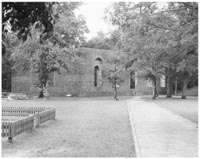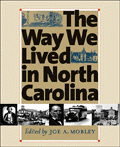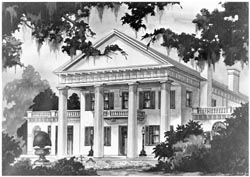
Ruins of St. Philip's Church (1754-68, burned 1776), Brunswick Town, Brunswick County.
|



PINE FOREST PLANTATIONS . . .
CHAPTER EXCERPTS
 ost of the early settlers in and around Brunswick Town came from South Carolina. By late 1726 leading South Carolina citizens were already complaining of the "Desertions from us to Cape Fear which is occasioned by the rigid usage of the merchants and lawyers." This "rigid usage" was due primarily to changes in the colony's naval-stores trade. As England's navy had expanded during the preceding half century, British officials had become increasingly anxious to obtain vital materials from their own colonies rather than from Baltic rivals. They looked to New England forests for masts and spars and to the southern colonies for the huge quantities of pitch and tar needed to protect the hulls and rigging of England's wartime and commercial fleet. Indeed, sailors applied tar with such regularity (much as modern seamen apply paint) that the men sailing before the mast became known collectively as "tars." ost of the early settlers in and around Brunswick Town came from South Carolina. By late 1726 leading South Carolina citizens were already complaining of the "Desertions from us to Cape Fear which is occasioned by the rigid usage of the merchants and lawyers." This "rigid usage" was due primarily to changes in the colony's naval-stores trade. As England's navy had expanded during the preceding half century, British officials had become increasingly anxious to obtain vital materials from their own colonies rather than from Baltic rivals. They looked to New England forests for masts and spars and to the southern colonies for the huge quantities of pitch and tar needed to protect the hulls and rigging of England's wartime and commercial fleet. Indeed, sailors applied tar with such regularity (much as modern seamen apply paint) that the men sailing before the mast became known collectively as "tars."
Although normally profitable, the production of naval stores could be less appealing when the price declined. As Governor Gabriel Johnston observed in 1734: "There is more pitch and tarr made in the two Carolinas than in all the other provinces on the Continent and rather more in this than in South Carolina but their two Commodities (tarr especially) bear so low a price in London (1000 Barrels scarce clearing 20s sterling) that I find the Planters are generally resolved to make no more."

Orton (ca. 1730; renovated ca. 1840, 1910), Brunswick County.
|
Although the naval-stores industry dominated the economy of the lower Cape Fear, a small quantity of rice also passed over the docks at Wilmington and Brunswick Town. In 1768 North Carolina exported only eighty-two barrels of rice, all from Cape Fear. By comparison, South Carolina exported 132,000 barrels in the same year. Rice cultivation required even more intensive labor than naval-stores manufacture. Only a few of the most wealthy Cape Fear planters owned enough slaves to make rice growing profitable. (Large slave ships from Africa rarely, if ever, visited the North Carolina colony; the ports were too small and the coastline too treacherous. Like other imports, slaves were expensive and often entered the province overland--frequently from Charleston.) Not surprisingly, the roots of Cape Fear rice cultivation lay in slave labor.
"The best Land for Rice," wrote a South Carolinian in 1761, "is a wet, deep, miry soil; such as is generally to be found in Cypress Swamps; or a black greasy mould with a Clay Foundation." Hugh Meredith traveled a short way up the Northeast Cape Fear River in 1730 or 1731 and found that "Boggy" swamps for rice cultivation abounded in the region. After sloshing across low-lying savannahs, he reported that the "Water was mostly ancle-deep on them." It was on land like this that Maurice Moore's brother Roger settled around 1725. By 1735 Roger Moore had named his plantation "Orton" and constructed a one-and-a-half-story brick home. A visitor to Cape Fear recorded in 1734 that Roger Moore, "hearing we were come, was so kind as to send fresh horses for us to come up to his house, which we did, and were kindly received by him; he being the chief gentleman in all Cape Fear. His house is built of brick, and exceedingly pleasantly situated about two miles from the town [Brunswick], and about half a mile from the river, though there is a creek comes close up to the door, between two beautiful meadows about three miles in length. He has a prospect of the town of Brunswick, and of another beautiful brick house, a building about half a mile from him, belonging to Eleazar Allen, Esq."

Just before the American Revolution, one observer noted the extraordinary affluence of whites in the coastal Cape Fear region. Ignoring the harsh circumstances of the region's black majority, or perhaps not even counting them as "people," he wrote that there were "fewer of the lower class of country people than [in] any part of the whole province." Though remarkably invisible to this and other white travelers, as well as generations of historians, the African American colonists of colonial Cape Fear did fully as much as the dominant English minority to shape the region's early economic and cultural development.
|

